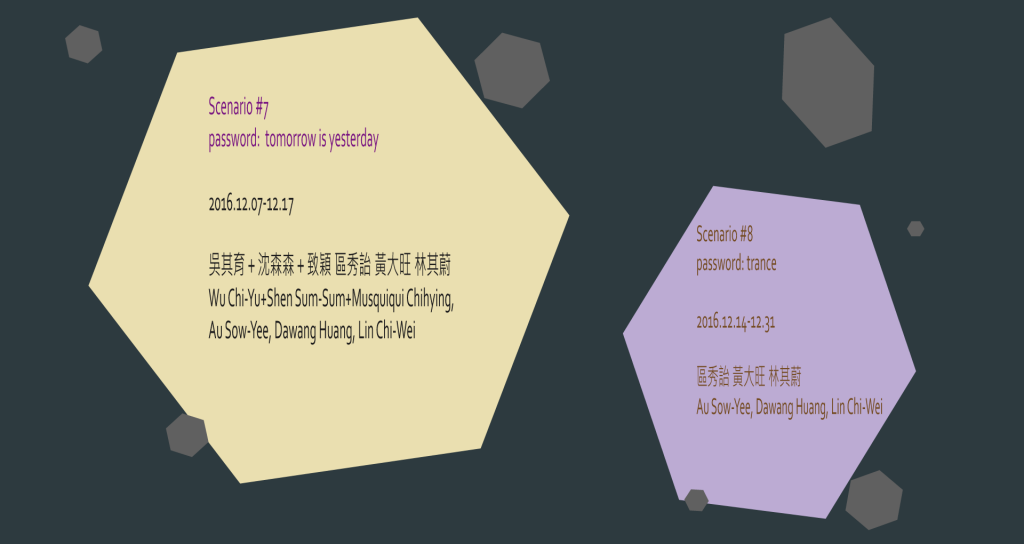For English, please scroll down.
「時間有重量嗎?」
「大概有回憶那麼重吧。」
「怎麼知道時間有多深呢?」
「隨著夢延伸啊。又好像詩歌一樣深,一代一代哼唱下去吧。」
「那麼,寬度呢?」
「跟你的步伐一樣寬啊,時間總是一步一步走出來的。也跟你的筆一樣細,隨著心飛高高。」
祖孫倆在夕陽掛下的黑影中對話著。
* * * *
把時間展開至多重向度進行回觀,是潛伏在這個場景裡的線索。為了將那些隱匿或被遺忘的律動、風光、故事和結構激顯出來,時間在此不再具有標準刻度,而是被其他度量反身檢視——老歌背後的時代風景、電影裡難以在場的愛情、冷戰間諜傳奇化身寓言的過程、意識與肉體間的對峙張力——歷史獲得形變撲向未來的瞬間在場景中融成夢般的山水。
黃大旺的老歌採集,透過在地散步路線地圖鋪陳30年代後的流行歌謠與都市地理紋路的跨時空拼貼,將帶著觀眾往大稻埕探走。這些在地歌謠史的曲目流露著底層尋常人物的多樣情感,旋律刻著舊時代的社會關懷、都會樣貌與討生活的艱辛。《跟著歌聲的腳步—甘寧涼歌謠小旅行路線圖》的作品標題卻同時詼諧地提出諷刺,批判近日各種文創發展中的小清新文化所對此區故有人文風景的冷漠消費,以及懷舊風格裡完全消失的時間厚度。當未來正如此消費過去之時,這場散步似乎也只能仰賴懸置於老歌的時光中才能再度貼近眼前街頭真實的生活。
《聲線計畫:梭羅河的歌》(吳其育+沈森森+致穎)藉著印尼歌謠《梭羅河的歌》把亞洲區域間相左歷史進程中的共時性串接起來,通往1951、1963、1971年三部電影背後所指涉之地理政治和歷史連動趨力。這些電影裡的愛情故事並在此計畫中相遇且產生對話,將其中未竟的情節留給彼此;透過聲音裝置展示當下所開放出的時間動態裡,更再度聯繫這首經典歌謠所可能牽絆的回憶與新的投射。
同樣架構在冷戰權力結構背景下的另一件作品透過杜撰多層次虛構敘事的手法,企圖演繹殖民影響、資源掠奪等政治操控所在歷史上,不斷異化生產的文化主體與其游離的邊界。《克里斯計劃II:If the Party Goes On》是區秀詒依據片斷史料並化名為Ravi所衍伸創作的離體電影。畫面素材包含了國泰電懋所製作的《空中小姐》、《曼波女郎》及她在馬來西亞所拍攝的場景。在結構、內容、時序及美學考量上,影像來回擺動在考據和虛構的對弈間,並伴有其他形式的文件共同建構敘事空間,以細密詩意的想像將未顯的歷史暗潮推上岸,被留白的遺忘形成黑影,轉化為新的寓言。
來自2001年的一次迷幻經驗,林其蔚在不經意的狀況下,花了一兩個鐘頭,閉著眼畫了一條線,成為《一線畫》、《雙線畫》的起點。幾年後,他決定持續花一整年的時間裡,每天睡前閉目畫一條直線,作為一種肌肉測量的生理性日記,也漸漸從單手轉變成雙手的練習。在放鬆的細膩畫面裡、在時間兩端點之間,直線竟具有複合性的規則律動:線條同時屬於身體和意識,通往內在、也朝向外在世界摸索前行;在一種與時間平行推移的測量和身體實踐狀態中,主體性也越過各種維度,在無限的時空中輕盈地體現,並打開自體成為媒介。
吳其育+沈森森+致穎
吳其育的創作往往透過口述歷史與傳說的紀錄與再製,並在敘事的解構與重構過程中,重新連結歷史紋理與生活場域斷裂的後現代人類文明。其目前工作與生活於台北。沈森森的創作則關注於聽覺所能引發的其他想像或感知,亦善於就意義上處理聲音本身所具備的符號及敘事性。其目前工作與生活於柏林。而藉著探討人和公共空間的相互關聯,致穎的創作所聚焦的美學命題則是關於資本如何改變人類生活習慣及作息。其目前工作與生活於台北與柏林。聲線計劃為此三位藝術家共同合作的創作項目。
黃大旺
黃大旺身為非當機中後媒體時代吟遊詩人、即興表演家、聲音wiki活體百科,以其噪雜失衡卻精準深刻的肢體和語言在滔滔資訊流中展開時代性的辯證。他以「黑狼那卡西」創作演出廣為人知,也在同人誌創作、文化研究上自成一格,其狂廢的精神世界、溫暖與暗黑並行的身態在台上台下都劃出一道透徹反思社會的歪光。目前工作與生活於台北。
區秀詒
在區秀詒的影像語彙中藉其深究田調訪、文獻考所集結之生命經驗,以歷史語境的爬梳,反映於高度思辨的音像部署。其創作上的美學探討,一是對影像(史)生成機制和其幽靈的關注,以機械式電影放映機而作的現場電影;二是以錄像、觀念、裝置等混合形式,探討和擴延影像與影像製造以及政治、權力之間的關係。目前工作與生活於台北。
林其蔚
早期作品多以噪音、行為等表演關注各種機制秩序、人體、社會的衝突與暴力,這些被納入其獨特暗黑垃圾美學的系列企圖回返並解放身體——既是媒介、是主體也是規訓,更已經成為現代性病徵之所具。近來創作探索聲音結構、儀式、文明符碼與能量交織之晦暗神秘領域,轉化為對當下政治社會的另類批判性啟示寓言。目前工作與生活於台北。
“Does time have weight?”
“It is probably the weight of memories.”
“How can you tell the depth of time?”
“It always expands along with your dreams. It is as deep as a song that can be passed down through generations in a melody.”
“What about the width of it?”
“It must be as wide as a footstep, because time is how you walk step by step. It must be as narrow as your pen too, because time coasts along and flies with your heart.”
In the shadows of sunset, the kid was chatting with his grandpa.
* * *
Unfolding time into multiple dimensions is the incessant hint towards investigating ways of seeing in this scenario. Time loses its standard here. It is instead measured by other artistic compositions—the landscape of an old era drawn out in a song, the hardly present romance in a movie plot, a Cold War spy legend turning into a new allegory, the tension between consciousness and body—to reveal the hidden rhythms, stories and structures time holds. When history experiences the moment of transfiguration, it, at once, leaps into the future while melting into a dreamlike scene.
Dawang Huang leads his audience into the old town of Dadaocheng with his time travel through songs. He samples the popular Taiwanese folk song from the 1930s. The juxtaposition of music and tour route revisits not only the neighborhood but also the emotions, urban scenes and life experiences that are the social concerns embedded in old-time lyrics. The Chinese title of the work Following the Footsteps of Singing – A Tour Guide to Walk Local, Sing Local further suggests an ironic criticism towards the recent hipster culture of the “creative industry” that is consuming the cultural landscape of the area by removing the depth of time in its flat retro style. When the future devours the past in such a manner, we can only rely on the time of these old folk songs to be able to observe the real life in front of our eyes during the tour.
Sound Route: Bengawan Solo (Wu Chi-Yu + Shen Sum-Sum + Musquiqui Chihying) finds and connects the synchronicity between three different movies’ that share the Indonesian folk song Bengawan Solo. It reveals the different historical processes in Asia and exposes the connected geopolitical motivations in 1951, 1963 and 1971. The love stories from three films encounter one another and begin to converse in this project, continuing to extract narrative fragments for one other. The sound installation also shares a new temporality with the audience, allowing new engagements with the memories evoked by this classic melody.
Another project that shared the same Cold War power structure is Kris Project II: If the Party Goes On by Au Sow-Yee. She employs multiple fictional narratives to interpret the cultural subject and its shifting boundaries generated from the colonial power, war over resources and other political manipulations in history. Masking herself under the synonym of Ravi, the mysterious figure found in her research, Au creates an out-of-body film, remixing footages from Air Hostess and Mambo Girl produced by the film giant Cathay-MP&GI with her own film shot in Malaysia. Accompanied by other forms of text, the imagery swings between research and fiction to construct a space for narration. The poetic imagination forms a new allegory, bringing the undercurrents of history ashore and exposing the shape of oblivion in the opposite shadow.
Inspired by a psychedelic experience from 2001 where, over a one-hour period Lin Chi-Wei attempted to delineate a straight line on a piece A4 paper with his eyes closed, the mindless departure becomes the motivation for his Polygraph project. A few years later, Lin decided to spend one hour every single day to draw a line before sleep for one year as a biographic diary to document his muscle activities. The practice also evolves from using a single hand to using both hands in making the drawings. In the delicate and relaxed composition, between times, the lines convey sets of complex patterns and frequencies. The line simultaneously belongs to body and consciousness, leading to both inner and exterior worlds in darkness. And in this bodily practice for measuring and documenting the parallel movements of time, subjectivity transgresses its diverse dimensions into a boundless sphere where the self becomes an agent.
WU Chi-Yu + SHEN Sum-Sum + Musquiqui Chihying
Sound Route is a collaboration between Wu, Shen and Musquiqui Chihying.
Wu Chi-Yu’s practice focuses on the recording and reproduction of oral histories and local rumor. Through the process of deconstructing and reconstructing these narratives, he aims to reconnect with a post-modern society which has become detached from history and community. Wu lives and works in Taipei. SHEN Sum-Sum’s interests lie in how imagination and perception is evoked by the experience of listening through the symbolic and narrative character of sound itself. Shen lives and works in Berlin. Musquiqui Chihying focuses on the relationship between the human body and the public domain, as well as how capital production twists everyday routine. Musquiqui Chihying lives and works between Taipei and Berlin.
Dawang HUANG
Half-crashed post-media bard, improviser, living sound Wikipedia – Dawang Huang enacts an epic debate among the speedy data flow with his idiosyncratic noise-language and profoundly unbalanced bodily expression. Best known for his Blackwolf Nagashi performances, he has created a genre unto himself in fanzine and cultural studies. His wild ‘scum’ world and obscure, yet warm attitude he approaches the ethics of modern society via a crooked path. Huang lives and works in Taipei.
AU Sow-Yee
Au Sow-Yee’s work takes two approaches rooted in moving images. One is her continuing interest in image-making mechanism and its ghost, creating live cinema performances using mechanical film projectors. Second is to question, explore as well as expand the relation between images, image-making, politics and power, through video installations and other mediums. Through her artistic language and dialectical approach to audio-visual “mapping”, she depicts the accumulation of a ‘bio-archive’ from her investigation into historical contexts. Au lives and works in Taipei.
LIN Chi-Wei
Lin’s early noise and performance series concern the confrontation and violence among institutional power, people and society. Human body as medium, subjectivity, site of order and embodiment of modern symptoms are the subject of his liberation of movement in his peculiar gothic garbage aesthetic. His recent interests explore the mysterious realm amongst sound structure, ritual, symbol and energy, transforming them into alternative allegories to criticize the contemporary social and political conditions.

